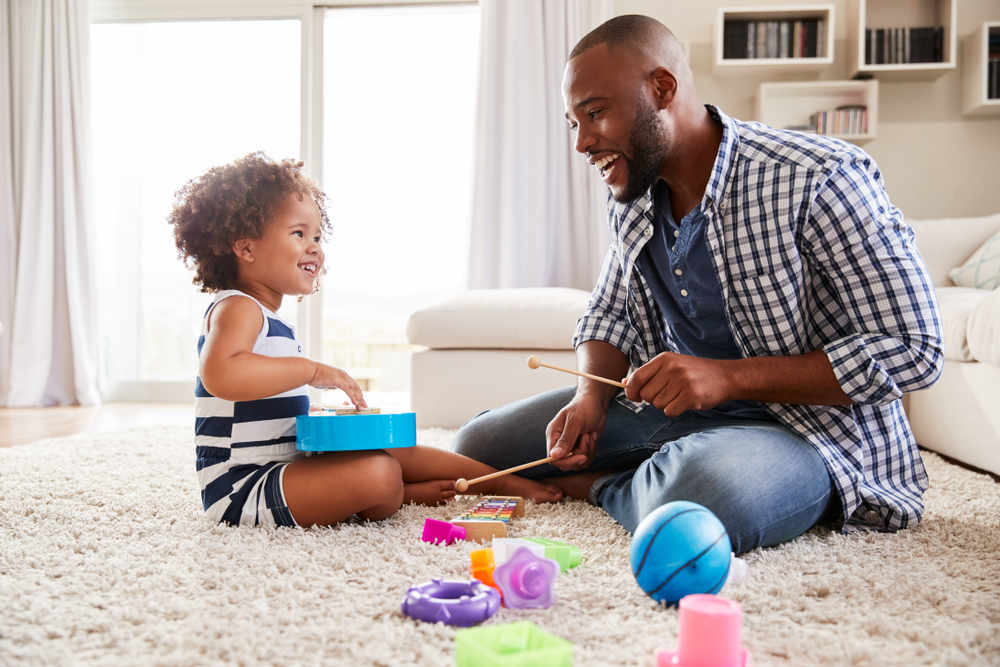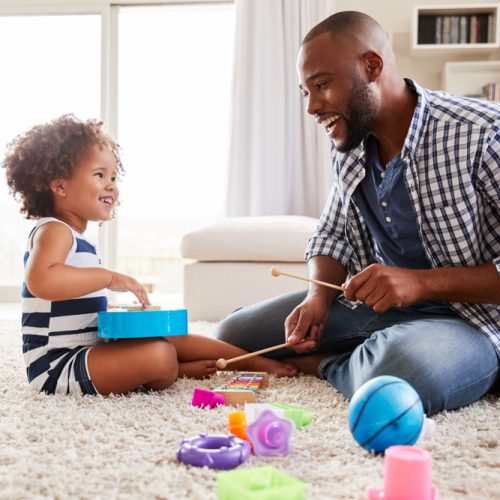The main takeaways for this guide take 2 minutes to read. It contains information from 8 sources, including the American Academy of Pediatrics and the CDC. See the full list below.
This guide will be updated again in September 2021. Know something we should add? Email us.
Playing comes naturally to children, but it can be hard for adults to figure out exactly how to join in playtime, and for how long.
A recent New York Times essay made the case that parents shouldn’t play pretend with their kids if they don’t enjoy it. We looked at what medical and psychology experts said on the matter, and they don’t exactly agree with that assessment (though the article itself is more nuanced than the headline.)
Here are some takeaways from our research:
- Experts all emphasize that play is important. It is a major way children develop and learn how to be part of our world.
- They also emphasize that kids need both unstructured play (i.e. without an adult or a stated goal to be achieved) and structured play (generally an activity facilitated by an adult.)
- Most sources aren’t calling on parents to play for hours at a time, and acknowledge that this can be difficult and draining. The CDC recommends playing with your kids 5-10 minutes per day.
- While most sources say it is helpful for kids to play with their parents, others disagree. We explain more below.
- Playing with your child isn’t just about pretending to be whatever they want. Several sources said simply watching and listening intently can be enough special attention from parents.
Want to know more? Keep reading below.

Sources That Say You Should Play With Your Kids
Experts all agree that play is especially important for children’s development, including play that isn’t structure or facilitated with any educational goal.
It is so important to the American Academy of Pediatrics that they released a report in 2018 that included an official policy recommendation that pediatricians “can be influential advocates by encouraging parents and child care providers to play with children and to allow children to have unstructured time to play.”
So, in other words, the official recommendation from the AAP is that kids get unstructured play on their own, and play with a parent and/or caretaker too.
The CDC also encourages parents to play directly with your kids, recommending 5-10 minutes each day. They also acknowledge that it takes time (and energy!) for parents to develop the skills they need during playtime, like actively describing what your child is doing and following their lead.
Here’s how they put it: “When parents first start using praise, description, imitation, and active listening, they find that it takes a lot of energy and focus. It is hard to use the skills for more than five minutes. You can increase the amount of time you spend with your child in special playtime as your skill level improves.”
We have more details on how to do this below.
Why Some Sources Caution Against Too Much Parental Play
There are a handful of experts who argue that playing with your kids isn’t always necessary. Prof. Peter Gray from Boston College in Psychology Today had one of the better descriptions as to how things can go awry:
“We mistakenly think our task is to allow our children to boss us. But bossing in either direction destroys play. Play requires negotiation and agreement, so everyone’s needs are met—not bullying and subservience. No self-respecting child playmate would tolerate being bossed around in such a way. A child playmate who got bored after 500 rounds of Discoball would say, in effect, ‘Either we play something else now or I’m out of here.’ “
Laura Markham, PH.D., has a similar argument in her own article for Psychology Today, and emphasizes that we could be teaching children they need to rely on parents to have fun:
“We’re teaching our children another lesson that we never intended: We’re the experts on play, just as on everything else. We have all the good ideas. To play the “right” way, they need us to play with them. We, the adults, are in charge of play. (Ridiculous, right?)”
Journalist Rebecca Onion at Slate has an extraordinarily detailed history of adults and kids playing, with lots of fascinating factoids. She cites several sources from the early 20th century that cautioned parents “to stay away from their children’s play altogether, because they’d ruin it.” She also interviewed a development psychologist who said there are many cultures where adults do not play with children and concluded: “And that’s just fine. There’s no requirement for playing.”
Ultimately Onion’s analysis ends with the message that parents should not force themselves into playing if they do not want to do. But she offers one skill that parents can work on developing: intently focusing on what your child is doing while that play (without your phone) and occasionally comment or participate in their game or the world they’ve created.
How To Observe and Participate In Child’s Play
Almost all sources that recommended parents play with their kids emphasized really listening to what they are doing or saying. Here is how the National Association for the Education of Young Children put it:
“Take time to watch and listen. Before joining your child’s play with your words or actions, take time to observe how your child is playing and experimenting. Not only will you delight in your child’s discoveries, you will also find that observing is a great way to get to know your child’s interests and gain an understanding about what he is learning. You may be surprised at how competent your child is when you focus on what he is doing.”
The CDC also has a list of recommendations on how to play successfully with your kids. It includes…
- Copying or mimicking things your child does or says. The idea is that your child will do whatever behavior you mimic more often.
- Describe what your child is doing as if you are a sports commentator
- Try not to ask too many questions (like “How was school?” or “Why are you doing that?”) and let your child lead the play time
- Limit specific directions and criticisms if possible so playtime is one part of the day where they aren’t hearing “no” and “don’t” all the time
What’s Age Appropriate?
This is list is adapted from the American Academy of Pediatrics.
Birth to 6 months:
- Responding with a smile
- Showing them a brightly colored toy
- Imitating babbles and coos to have a conversation
7 to 12 months:
- Safe spot to crawl and explore
- Dropping a toy to show that their actions have an effect
- Peek a boo
1 to 3 years:
- Unstructured playtime, especially at school or childcare settings
- Playing with other children
- Walking, jumping, standing on one leg
- Make-believe play, like pretending to drink out of an empty cup
- Singing songs and rhymes
- Reading books
4 to 6 years:
- Sing and dance
- Tell stories and ask questions what they remember
- Let your child act out imaginary scenes, roles on their own
Sources
Don’t Play With Your Kids. Seriously. – The New York Times (nytimes.com)
Just Play with Me: What Research Tells Us About Playing More Confidently with Our Children | NAEYC
Parent-child play: It’s constant and exhausting, but is there a better way? (slate.com)
Playing With Children: Should You, and If So, How? | Psychology Today
Special Playtime | Communicating with Your Child | Essentials | Parenting Information | CDC
Supporting Your Child to Play Independently: Free Play | Psychology Today
The Power of Play – How Fun and Games Help Children Thrive – HealthyChildren.org

